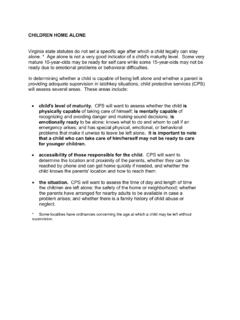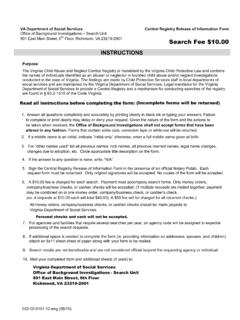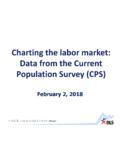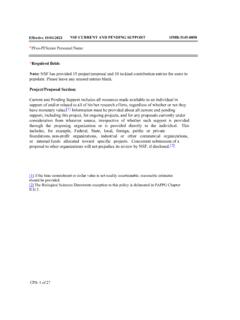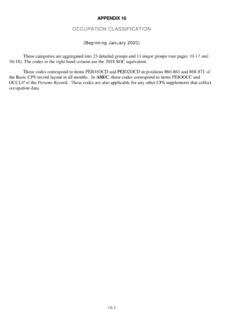Transcription of Calculating Approximate Standard Errors and Confidence ...
1 Bureau of Labor Statistics current population survey (CPS) Technical Documentation November 2018 #reliability Calculating Approximate Standard Errors and Confidence Intervals for current population survey Estimates This document provides information about Calculating Approximate Standard Errors for estimates from the current population survey (CPS). It also includes examples of how Confidence intervals for estimates can be calculated. A November 2018 update of this document introduces and parameters and a slightly different methodology for Calculating Standard Errors .
2 The CPS sample size is designed to meet a specified reliability criteria for unemployment estimates at the national and state level. The requirement is that, assuming a national unemployment rate of percent, an over-the month change of roughly percentage points be statistically significant at the 90-percent level of Confidence . A table showing changes in selected labor force indicators with statistical significance tests is online at #reliability. The table is updated each month with the publication of the Employment Situation news release. Approximate Standard Errors and Confidence intervals for CPS estimates can be calculated using instructions in this document and the parameter and factor tables (PF-1 through PF-16) available online at (These tables mirror tables A-1 through A-16 of the monthly Employment Situation news release.)
3 The parameter and factor tables allow users to calculate Approximate Standard Errors for a wide range of estimated levels, rates, and percentages, and also changes over time. The parameters and factors are used in formulas that are commonly called generalized variance functions. Reliability of current population survey Estimates An estimate based on a sample survey like the CPS has two types of error sampling error and nonsampling error. The estimated Standard Errors provided in this publication are approximations of the true sampling Errors . They incorporate the effect of some nonsampling Errors in response and enumeration, but do not account for any systematic biases in the data.
4 2 Nonsampling error Nonsampling error refers to Errors due to factors that are not related to sample selection. These Errors can be attributed to many sources, and many would affect results of a census as well as a survey . These sources include: The sampling frame may have imperfections. For example, the frame may exclude some housing units. Other housing units may be included in error or appear more than once. This can cause undercoverage or overcoverage. Household rosters may inadvertently exclude persons or include persons. Also, based on scope definitions by age or other criteria, Errors may cause a person to be inadvertently be excluded or included.
5 This may cause undercoverage or overcoverage that can vary, particularly by demographic characteristics. Questions may not be designed properly, though extensive testing makes this a minor issue for CPS. Responses to some items may be incorrect or may be missing entirely. For example, questions may be misinterpreted, or a person giving information about another may not have sufficient knowledge to provide correct information. Housing unit nonresponse may introduce bias. No response is obtained from about 10% of the housing units determined to be eligible (in scope) for a number of reasons. For example, some housing units refuse to cooperate, and no successful contact is made with others.
6 If responding households have different characteristics than nonresponding households, the estimates may be biased. Statistical methods to fill in for missing data or to correct for housing unit nonresponse are imperfect. Ratio estimation (used in second-stage weighting and composite weighting) is known to introduce small biases. CPS composite estimation is affected by month-in-sample (MIS) bias. One trait of MIS bias is that the estimated unemployment rate for a panel (or rotation group) is highest when it is first included in the CPS. There can also be Errors made by interviewers, even falsification. These Errors are minimized by thorough training, use of laptops for administering interviews, routine quality control checks, and a reinterview program.
7 Data transmission and processing Errors are possible, but should be eliminated by CPS quality control procedures. The full extent of nonsampling error in the CPS is unknown. The effect is small on estimates of relative change, such as month-to-month change. The effect is small on means and rates, particularly unemployment rates. Estimates of monthly levels tend to be affected to a greater degree. More information can be found in current population survey Design and Methodology (Technical paper 66, October 2006) online at 3 Sampling error and Confidence intervals When a sample, rather than the entire population , is surveyed, estimates differ from the true population values that they represent.
8 The component of this difference that occurs because samples differ by chance is known as sampling error, and its variability is measured by the Standard error of the estimate. A sample estimate and its estimated Standard error can be used to construct Confidence intervals; when these estimates are unbiased, the statistical properties of Confidence interval coverage are known. The following are examples of Confidence intervals: A 90% Confidence interval is the range from Standard Errors below the estimate to Standard Errors above the estimate. The true population value is unknown, but there is an Approximate 90% probability that the interval includes or covers the true population value.
9 A 95% Confidence interval is the range from Standard Errors below the estimate to Standard Errors above the estimate. The true population value is unknown, but there is an Approximate 95% probability that the interval includes or covers the true population value. Confidence interval statements like these are approximately true for the CPS, and this is especially so for rates and changes over time. For a more complete explanation of Confidence interval coverage refer to a Standard survey methodology text, such as chapter in the 3rd edition of Sampling Techniques by William G Cochran (Wiley, 1977). When examining differences between estimates, the question often asked is: are the two estimates significantly different?
10 The difference may be for the same characteristic at two different time periods: is the change significantly different? The difference may be between different subpopulations in the same time period, such as the unemployment rate for men versus the unemployment rate for women. Given an unbiased estimate of difference/change and an unbiased estimate of Standard error for that difference/change, Confidence intervals can be constructed and statements such as the following can be made: If zero lies outside of the 90% Confidence interval from Standard Errors below the estimate to Standard Errors above the estimate, the difference/change is said to be significantly different at the 90% level of Confidence .










